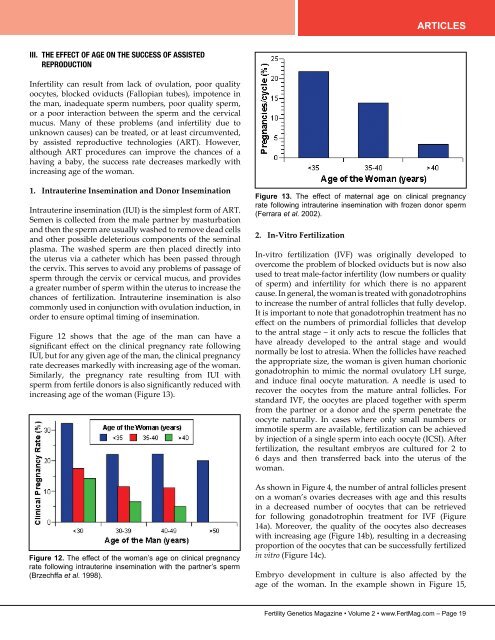FERTILITY GENETICS
TCqTZH
TCqTZH
You also want an ePaper? Increase the reach of your titles
YUMPU automatically turns print PDFs into web optimized ePapers that Google loves.
ARTICLES<br />
III. THE EFFECT OF AGE ON THE SUCCESS OF ASSISTED<br />
REPRODUCTION<br />
Infertility can result from lack of ovulation, poor quality<br />
oocytes, blocked oviducts (Fallopian tubes), impotence in<br />
the man, inadequate sperm numbers, poor quality sperm,<br />
or a poor interaction between the sperm and the cervical<br />
mucus. Many of these problems (and infertility due to<br />
unknown causes) can be treated, or at least circumvented,<br />
by assisted reproductive technologies (ART). However,<br />
although ART procedures can improve the chances of a<br />
having a baby, the success rate decreases markedly with<br />
increasing age of the woman.<br />
1. Intrauterine Insemination and Donor Insemination<br />
Intrauterine insemination (IUI) is the simplest form of ART.<br />
Semen is collected from the male partner by masturbation<br />
and then the sperm are usually washed to remove dead cells<br />
and other possible deleterious components of the seminal<br />
plasma. The washed sperm are then placed directly into<br />
the uterus via a catheter which has been passed through<br />
the cervix. This serves to avoid any problems of passage of<br />
sperm through the cervix or cervical mucus, and provides<br />
a greater number of sperm within the uterus to increase the<br />
chances of fertilization. Intrauterine insemination is also<br />
commonly used in conjunction with ovulation induction, in<br />
order to ensure optimal timing of insemination.<br />
Figure 12 shows that the age of the man can have a<br />
significant effect on the clinical pregnancy rate following<br />
IUI, but for any given age of the man, the clinical pregnancy<br />
rate decreases markedly with increasing age of the woman.<br />
Similarly, the pregnancy rate resulting from IUI with<br />
sperm from fertile donors is also significantly reduced with<br />
increasing age of the woman (Figure 13).<br />
Figure 12. The effect of the woman’s age on clinical pregnancy<br />
rate following intrauterine insemination with the partner’s sperm<br />
(Brzechffa et al. 1998).<br />
Figure 13. The effect of maternal age on clinical pregnancy<br />
rate following intrauterine insemination with frozen donor sperm<br />
(Ferrara et al. 2002).<br />
2. In-Vitro Fertilization<br />
In-vitro fertilization (IVF) was originally developed to<br />
overcome the problem of blocked oviducts but is now also<br />
used to treat male-factor infertility (low numbers or quality<br />
of sperm) and infertility for which there is no apparent<br />
cause. In general, the woman is treated with gonadotrophins<br />
to increase the number of antral follicles that fully develop.<br />
It is important to note that gonadotrophin treatment has no<br />
effect on the numbers of primordial follicles that develop<br />
to the antral stage – it only acts to rescue the follicles that<br />
have already developed to the antral stage and would<br />
normally be lost to atresia. When the follicles have reached<br />
the appropriate size, the woman is given human chorionic<br />
gonadotrophin to mimic the normal ovulatory LH surge,<br />
and induce final oocyte maturation. A needle is used to<br />
recover the oocytes from the mature antral follicles. For<br />
standard IVF, the oocytes are placed together with sperm<br />
from the partner or a donor and the sperm penetrate the<br />
oocyte naturally. In cases where only small numbers or<br />
immotile sperm are available, fertilization can be achieved<br />
by injection of a single sperm into each oocyte (ICSI). After<br />
fertilization, the resultant embryos are cultured for 2 to<br />
6 days and then transferred back into the uterus of the<br />
woman.<br />
As shown in Figure 4, the number of antral follicles present<br />
on a woman’s ovaries decreases with age and this results<br />
in a decreased number of oocytes that can be retrieved<br />
for following gonadotrophin treatment for IVF (Figure<br />
14a). Moreover, the quality of the oocytes also decreases<br />
with increasing age (Figure 14b), resulting in a decreasing<br />
proportion of the oocytes that can be successfully fertilized<br />
in vitro (Figure 14c).<br />
Embryo development in culture is also affected by the<br />
age of the woman. In the example shown in Figure 15,<br />
Fertility Genetics Magazine • Volume 2 • www.FertMag.com – Page 19


